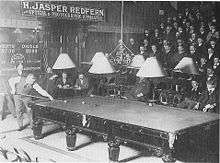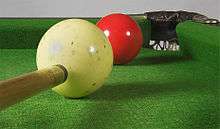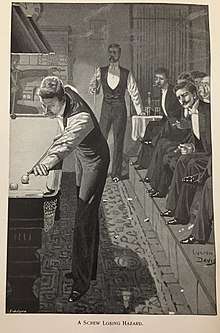English billiards
English billiards,[1] called simply billiards in the United Kingdom,[2] where it originated, and in many former British colonies such as Australia, is a cue sport that combines the aspects of carom billiards and pocket billiards. Two cue balls (historically both white, with one marked with a dot, but more recently one white and one yellow) and a red object ball are used. Each player or team uses a different cue ball. It is played on a billiards table with the same dimensions as a snooker table and points are scored for cannons and pocketing the balls. English billiards has also, but less frequently, been referred to as "the English game", "the all-in game" and (formerly) "the common game".[3]

History
English billiards was originally called the winning and losing carambole game, folding in the names of three predecessor games, the winning game, the losing game and the carambole game (an early form of straight rail), that combined to form it.[3]
Origins
The winning game was played with two white balls, and was a 12-point contest. To start, the player who could strike a ball at one end of the table and get the ball to come to rest nearest the opposite cushion without lying against it earned the right to shoot for points first. This is the origin of the modern custom of "stringing" (or "lagging"). A player who pocketed the opponent's ball scored two points,[3] as is still the case in modern billiards.
Fouls (or faults): A player missing the opponent's ball added one point to his opponent's total; the shooter conceded two points if that player's own ball (then acting as the cue ball) went into a pocket after striking the opponent's ball; and the player conceded three points if the cue ball was pocketed without even hitting the opponent's ball. These rules continued to exist in English billiards until 1983, when a standard two points for all fouls was introduced.
By contrast, in the losing game a player could only score (2 points) by pocketing the cue ball through a carom off the opponent's ball.[3] "Winning hazard" and "losing hazard" are terms still mentioned in the official rules for these two fundamental shot types, although "pot" and "in-off" have become the usual terms for them in British English.
The final element was the cannon (or carom) shot, which came from carom or carambole billiards, a three-ball game popular in various countries of western Continental Europe, especially popularized by France[4] (and today also popular in many parts of Asia and South America). In the 1700s, the carambole game added a red object ball to the two white cue balls, and dispensed with the pockets.[5] This ball was adopted into the English game, which retained the pockets,[5] and the goal was to cannon off both the red and the opponent's ball on a single shot, earning 2 points. This influence on the English game appears to have come about through the popularity of French tables in English coffee houses; London alone had over two thousand such establishments in the early 18th century.[6] One period advertisement read: "A very good French Billiard Table, little the worse for wearing, full size, with all the materials fit for French or English play".[6]
The three ancestral games had their British heyday in the 1770s, but had combined into English billiards, with a 16-point score total, by approximately 1800.[3] The skill required in playing these games helped retire the billiard mace in favour of the cue.
There are a number of pocket billiard games directly descended from English billiards, including bull dog, scratch pool, thirty-one pool and thirty-eight. The last of these gave rise to the more well-known game cowboy pool.[7][8] English Billiards was virtually unknown in the United States until 1913, when Melbourn Inman visited the US and played the game against Willie Hoppe. By 1915 the game had become rather popular, prompting American billiard hall proprietors of the period to increase the number of English-style tables in their establishments.[9] It also became favored in British colonies; the game's longest-running champion was an Australian, Walter Lindrum, who held the World Professional Billiards Championship from 1933 until his retirement in 1950. The game remains popular in the UK, although it has been eclipsed by snooker.
As a sport
The first governing body of the game, the Billiards Association, was formed in the UK in 1885, a period that saw a number of sporting bodies founded across the British sporting world.[10] By the mid-20th century, the principal sanctioning body was the Billiards Association and Control Council (later the Billiards and Snooker Control Council), formed in 1919 by an amalgamation of the Billiards Association and the Billiards Control Club (founded in 1908).
In the 19th century and up through the mid-1950s, a common way for championship titles to change hands was by a challenge match. A challenge was issued to a championship title holder accompanied by stake money ("acclamation") held by a third party.[11] Up until the first organised professional tournament in 1870, all English billiards champions were decided by challenge.
The first champion was Jonathan Kentfield, who held the title from 1820–1849, losing it to John Roberts, Sr. after Kentfield refused his challenge. Roberts's 21-year reign lasted until he lost to William Cook in 1870. That year was also the first in which an English billiards challenge match was held in the United States.[3]
From 1870 to 1983 the champions were: John Roberts, Jr., (1870, 1871, 1875–77, 1885); Joseph Bennett, (1870, 1880–81); Charles Dawson, (1899–1900, 1901, 1903); H.W. Stevenson, (1901, 1909–11); Melbourne Inman, (1908–09, 1912–19); Willie Smith, (1920, 1923); Tom Newman, (1921–22, 1924–27); Joe Davis, (1928–32); Walter Lindrum, (1933–50); Clark McConachy, (1951-68); Rex Williams, (1968–76, 1982–83); and Fred Davis, (1980).[3]
A "Women's Billiard Association" was formed in Britain in 1931. One of the founders was Teresa Billington-Greig who had been a leading suffragette and was then married to a billiard ball manufacturer.[12]
Over the course of the 20th century, English billiards has been increasingly superseded as the favoured competitive spectator cue sport in the United Kingdom by the game of snooker played on the same table. However, because of the "in-off" scoring option, ball control (including for snooker) can be enhanced after much solo practice. A common exercise is to hit the object ball from the "D", go in-off into the centre pocket while the object ball hits the top cushion and returns to the same position halfway down the table. A highly skilled player can repeat the shot over and over, except in competition where the sequence run is limited, because it constitutes a nurse shot.
Rules
Balls and table
There are three balls. They are the same size as snooker balls (52.5 mm or 2 1⁄16 in with a tolerance of 0.05 mm) and they must weigh the same to a tolerance of 0.5 g within a set.[13]
The balls are designated as:
- Red, an object ball;
- White, the cue ball for player 1, and an object ball for player 2;
- White with a spot, or yellow, cue ball for player 2, and an object ball for player 1.[14]
The billiard table used has the same dimensions as a snooker table,[13] (and in many venues, both games are played on the same equipment). The playing area of a standard tournament table measures 11 feet 8 inches by 5 ft 10 in (3.569 m by 1.778 m) with a tolerance of 1⁄2 inch (1.26 cm) in both directions, though smaller ones, down to half size, are often found in snooker halls, pubs and home billiard rooms.
Beginning the game

To see who will be the starting player, both players simultaneously hit a cue ball up the table, bouncing it off the top cushion so that it returns to baulk (the first quarter-length of the table). The player who gets his ball closer to the baulk cushion can now choose which cue ball he wants to use during the game and to break or let the opponent break.
The red ball is placed on the spot at the top of the table (same as the black spot in snooker) and the first player begins by playing in-hand from the "D" behind the baulk line. The other cue ball remains off the table until the opponent's first turn, when he plays in hand from the "D".
The idea is to leave the balls safe by creating either a double baulk (both object balls in baulk), or the red in baulk with the cue-ball tight (frozen) to the top-side cushion.
Scoring

Points are awarded as follows:
- Cannon – striking the cue ball so that it hits, in any order, the other cue ball and the red ball on the same shot: 2 points.
- Winning hazard (or potting, in snooker terms) – striking the red ball with one's cue ball so that the red enters a pocket: 3 points; or striking the other cue ball with one's cue ball so that the other cue ball enters a pocket: 2 points.
- Losing hazard (in-off in snooker terms) – striking one's cue ball so that it hits another ball and then enters a pocket: 3 points if the red ball was hit first; 2 points if the other cue ball was hit first; 2 points if the red and the other cue ball are hit simultaneously.
Combinations of the above may all be scored on the same shot. The most that can be scored in a single shot is therefore 10 – the red and the other cue ball are both potted via a cannon (the red must be struck first), and the cue ball is also potted, making a losing hazard off the red.
Winning is achieved by a player reaching a fixed number of points, determined at the start of the game, e.g. first to 300 points or by a timed game.
Other rules
If the red is potted it is respotted on the spot at the top of the table (the black spot). After the red has been potted twice off the spot in a row (i.e. without a cannon or losing hazard), it is respotted on the middle spot. If the middle spot is occupied, it goes on the pyramid spot (the pink spot in snooker). If both the middle and pyramid spots are occupied, it goes back on the spot. When potted from the middle or pyramid spot, it returns to the spot at the top of the table.
After a losing hazard, play continues in-hand from the "D". When playing from in-hand, a striker must touch a ball or cushion out of baulk before striking a ball in baulk.
If playing in-hand and all balls on the table are in baulk, and contact is not made with any ball, this is a miss; 2 points are awarded to the opponent, who must play from where the balls have come to rest.
If an opponent's cue ball is potted, it remains off the table until it is that opponent's turn to play, when it is returned to that player, who may play it in-hand from the "D". There is one exception to this rule: only 15 hazards in a row may be played, after which a cannon is needed to continue the break. If only the red ball is on the table at the start of the break (meaning a cannon cannot be made), then after 15 hazards the opponent's ball must be placed on the "brown spot". It becomes a "line ball" and may not be played directly from baulk.
If the cue ball is touching an object ball, then the balls must be respotted: red on its spot and opponent's ball in the centre spot, with the striker to play from in-hand.
Matches held under professional regulations include a rule forcing the player to execute a shot in a way to have his cue ball cross the baulk line, heading towards the baulk cushion, once between 80 and 99 points in every 100 in a running break.
Fouls
If a foul occurs, two points are awarded to the opposing player who has the choice of playing from where the balls lie or they can be respotted.
There are a few different ways a foul can occur by:
- Playing/Striking the opponent's cue ball or Red object ball
- Making any ball jump off the table
- Failing to make contact between one's cue ball and at least one object ball (unless double baulked)
- A double-hit or push shot
- Jumping one's cue ball over an object ball
- Playing a 16th consecutive hazard or 76th consecutive cannon
- When in-hand, not hitting an object ball or cushion out of baulk before hitting a ball in baulk.
See also
Notes
- "Welcome to englishBilliards.org!". Retrieved 2 February 2017.
- Everton 1986 Serves as a good example; the book refers to English billiards simply as "billiards", from cover to cover.
- Shamos 1999, p. 89.
- Shamos 1999, p. 243.
- Stein & Rubino 2008, p. 81
- Stein & Rubino 2008, p. 80
- Shamos 1999, pp. 61–62.
- NYT staff 1885
- NYT staff 1915
- Midwinter 2007, p. 59
- Shamos 1999, p. 46.
- "Teresa Billington-Greig". WCML. Retrieved 2018-10-16.
- Kumar 2000, p. 101
- Kumar 2000, pp. 101–104.
References
- Everton, Clive (1986). The History of Snooker and Billiards (rev. ver. of The Story of Billiards and Snooker, 1979 ed.). Haywards Heath, UK: Partridge Pr. ISBN 1-85225-013-5.CS1 maint: ref=harv (link)
- Kumar, Ashok (2000). International encyclopaedia of sports and games. 1. Mittal Publications. ISBN 81-7099-747-X.CS1 maint: ref=harv (link) This tertiary source reuses information from other sources but does not name them.
- Midwinter, Eric (2007). "The Football Association". Parish to Planet: How Football Came to Rule the World. Studley, UK: Know the Score Books. p. 59. ISBN 978-1-905449-30-9.CS1 maint: ref=harv (link)
- NYT staff (21 January 1885). "The Thirty-eight Game". New York Times. Retrieved 13 December 2006.CS1 maint: ref=harv (link) Copied from the Rochester Democrat, which published the article on 18 January 1885.
- NYT staff (21 November 1915). "English Billiards Grows. Recently Imported Game Now Quite Popular Here". The New York Times. Retrieved 2 February 2017.CS1 maint: ref=harv (link)
- Shamos, Mike (1999). The New Illustrated Encyclopedia of Billiards. New York City: Lyons Press. ISBN 1-55821-797-5.CS1 maint: ref=harv (link)
- Stein, Victor; Rubino, Paul (2008) [1994]. The Billiard Encyclopedia (3rd ed.). New York City: Balkline Press. ISBN 978-0-615-17092-3.CS1 maint: ref=harv (link)
External links
| Wikimedia Commons has media related to English billiards. |
- World Billiards (World Billiards Official website)
- International Billiards and Snooker Federation
- EnglishBilliards.org – Coaching website, general information, tutorials, etc.
- English Billiards Statistics Project – player stats and Elo rating list
- Official Rules of English Billiards Published by WPBSA November 2014
